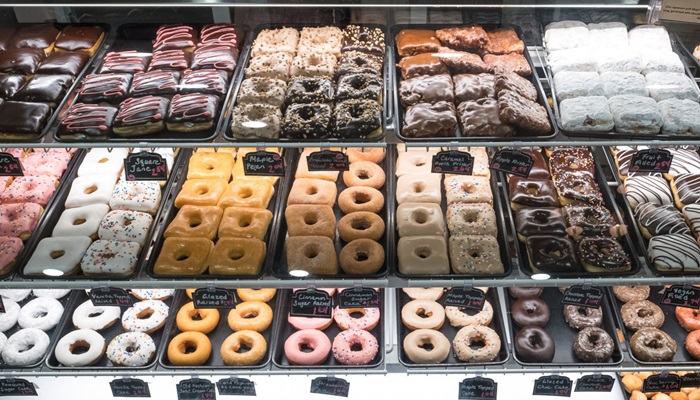Greggs, a well-known British bakery chain, has become synonymous with high-quality pastries and baked goods, including their famous donuts. Understanding the competitive landscape for Greggs donuts nationally requires a comprehensive analysis of the bakery market, competitors, consumer preferences, and market trends. This article delves into these aspects to provide a detailed picture of the competition Greggs faces in the UK.
Greggs’ Market Position
Greggs has established itself as a leading bakery chain in the UK, with over 2,000 outlets across the country. The brand is known for its affordability, convenience, and wide range of products, including donuts, sausage rolls, sandwiches, and beverages. Greggs’ strong brand recognition and extensive network of stores give it a significant advantage in the competitive bakery market.
Competitor Analysis
1. Supermarket Chains
Supermarkets like Tesco, Sainsbury’s, and ASDA offer a variety of bakery products, including donuts. These supermarkets have the advantage of large-scale operations and can offer competitive pricing. They attract customers with convenience, as shoppers can purchase baked goods along with their groceries.
2. Independent Bakeries
Independent bakeries provide artisanal and often locally-sourced baked goods, including donuts. They compete on quality, uniqueness, and customer loyalty. Many customers prefer independent bakeries for their personalized service and the appeal of supporting local businesses.
3. Other Bakery Chains
Bakery chains like Krispy Kreme and Dunkin’ Donuts present direct competition to Greggs in the donut segment. These brands are known for their specialty donuts and unique flavors, attracting donut enthusiasts who seek variety and novelty.
Consumer Preferences and Trends
1. Health Consciousness
Consumers are increasingly becoming health-conscious, seeking out baked goods with healthier ingredients. This trend has led to the rise of gluten-free, vegan, and low-sugar options. Greggs has adapted to this trend by offering a range of healthier options, but the competition is also fierce in this segment.
2. Convenience
Convenience is a major factor for consumers when choosing where to buy baked goods. Greggs benefits from its widespread presence and convenient locations, often in high-traffic areas like city centers, train stations, and shopping malls.
3. Price Sensitivity
Price is a critical factor for many consumers. Greggs’ pricing strategy aims to provide affordable options without compromising on quality. However, supermarkets and discount stores often undercut prices, offering similar products at lower prices, which adds to the competition.
Market Trends
1. Rise of Online Ordering and Delivery
The COVID-19 pandemic accelerated the shift towards online ordering and delivery. Many bakery chains and independent bakeries have adapted to this trend by offering online ordering systems and partnering with delivery services. Greggs has also embraced this trend, but it faces stiff competition from both large chains and local bakeries that have optimized their online presence.
2. Specialty and Gourmet Donuts
There is a growing demand for specialty and gourmet donuts. Brands like Krispy Kreme and Dunkin’ Donuts excel in this area, offering unique flavors and limited-edition products. Greggs has introduced new flavors and seasonal offerings to compete, but maintaining a balance between innovation and their core product range is essential.
Greggs’ Competitive Strategies
1. Product Innovation
Greggs continually innovates its product range to keep up with consumer preferences and trends. Introducing new flavors, healthier options, and seasonal products helps Greggs stay relevant and attract a diverse customer base.
2. Strategic Locations
The strategic placement of Greggs stores in high-traffic areas is a significant competitive advantage. Convenience is a key selling point, and being easily accessible to customers boosts sales.
3. Loyalty Programs and Promotions
Greggs’ loyalty program, Greggs Rewards, offers customers incentives and promotions, encouraging repeat business. Regular promotions and meal deals also attract price-sensitive customers.
4. Emphasis on Quality and Consistency
Maintaining high quality and consistency across all outlets is crucial for customer satisfaction and loyalty. Greggs invests in staff training and quality control measures to ensure that customers receive the same standard of products at any location.
Challenges in the Competitive Landscape
1. Economic Factors
Economic downturns and rising costs can affect consumer spending power and operational costs. Greggs must navigate these challenges by balancing pricing strategies and cost management.
2. Changing Consumer Preferences
Adapting to rapidly changing consumer preferences requires agility and foresight. Greggs needs to continually research and understand market trends to stay ahead of competitors.
3. Local Competition
Independent bakeries and local chains often have a loyal customer base and can pose significant competition, especially in smaller towns and communities where local businesses are preferred.
Opportunities for Growth
1. Expanding Healthier Options
The demand for healthier baked goods presents an opportunity for Greggs to expand its range of gluten-free, vegan, and low-sugar products. Catering to health-conscious consumers can attract a new customer segment.
2. Enhancing Online and Delivery Services
Improving online ordering and delivery services can help Greggs capture a larger share of the market. Partnering with delivery platforms and optimizing their online presence can boost sales.
3. Exploring New Markets
Expanding into new geographical markets within the UK and potentially internationally can provide growth opportunities. Greggs can leverage its brand strength and operational expertise to enter new markets. Entering into the Greggs Franchise space can be a lucrative opportunity for aspiring entrepreneurs. However, like any business venture, it requires an initial investment. The Greggs Franchise Cost typically ranges from £150,000 to £200,000.
see also: Where Is the Original Greggs?
Conclusion
The level of competition for Greggs donuts nationally is significant, with various players in the market, including supermarket chains, independent bakeries, and other bakery chains. Greggs’ strong brand, extensive network of stores, and focus on product innovation give it a competitive edge. However, the company must continually adapt to changing consumer preferences, economic factors, and market trends to maintain its position.
By focusing on quality, convenience, and customer loyalty, Greggs can navigate the competitive landscape and continue to thrive in the national bakery market.

